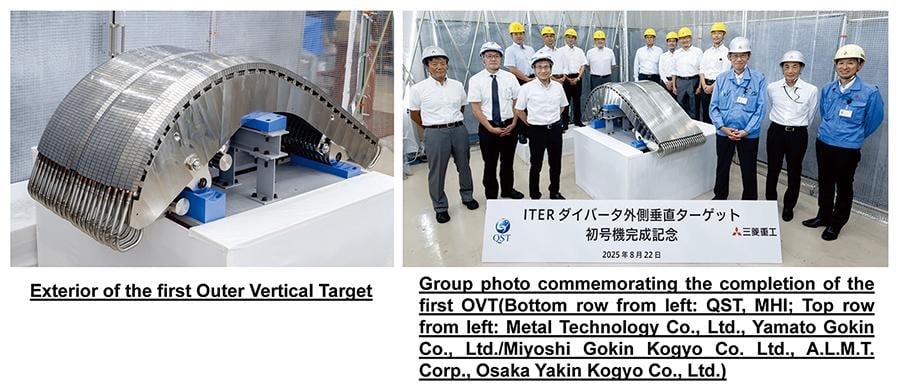Tokyo, December 2, 2025 – Mitsubishi Heavy Industries, Ltd. (MHI) and National Institutes for Quantum Science and Technology (QST), as part of the effort to manufacture components to be used in the ITER experimental fusion reactor(Note1),(Note2) under construction in southern France, have completed the manufacturing of the first Outer Vertical Target (OVT), one of the key components of the ITER Divertor. MHI and QST have been working on the production of the OVT since June 2020, and in July 2024 completed a prototype. Utilizing the knowledge and experience with manufacturing and inspection developed through this effort, the first OVT was completed solely by Japanese manufacturers. MHI will continue to focus on the mass production of the OVT and advance the ITER Project.

The divertor is one of the most crucial components in magnetic field confined to fusion reactors such as tokamaks. It plays an important role in the removal and expelling of unburned fuel in the core plasma, and impurities such as helium generated by the fusion reaction, in order to sustain the fusion reaction in a stable manner.
The heat load on the divertor target reaches a maximum of 20MW/m². This is equivalent to the surface thermal load on an asteroid probe during re-entry into the atmosphere, and approximately 30 times the surface thermal load on a Space Shuttle. The divertor is the component of the tokamak device that directly receives plasma, so it is used in a severe environment where it is exposed to the heat load and high energy particle loading from the plasma. For this reason, the divertor is made using special materials such as tungsten, which has a high melting point but is difficult to machine. In addition, along with the overall shape, the plasma facing surface is processed with minute shapes, requiring high-precision manufacturing and processing technology, such as the need for accuracy of 0.5 mm or less for machining the inclinations, level differences, and clearance of the plasma facing material.
QST, backed by its innovative R&D capabilities, has been focusing on R&D for divertors since before the ITER project, and MHI has leveraged its outstanding manufacturing capabilities to successfully produce the OVT, which from the standpoint of manufacturability, is the most difficult component of ITER’s in-vessel components.
QST has previously worked on the production of toroidal field (TF) coils, another core component of ITER, and by the end of 2023 had shipped all of the nine TF coils consigned to Japan to the ITER site.(Note3) MHI was responsible for five of the nine TF coils. MHI is handling production of all 38 of the 58 OVTs to be delivered by QST to ITER, including this first OVT. Beginning with this completed first OVT MHI plans to start delivering the units sequentially from fiscal 2025.
With the completion of this first OVT of the Divertor, Japan’s industry, academia, and government are making a concerted effort and taking a more proactive role in the ITER project, which is working to develop the technologies that will be crucial for the sustainable development of the world. MHI will also play a role in the development of the prototype fusion reactor planned to be built following the ITER project.
- 1Fusion is the source of energy that enables the sun to keep shining. The ultimate goal is achieving fusion on Earth. Fusion reactions fuse light atomic nuclei (deuterium and tritium) in a plasma environment into the heavier element of helium. Fusion energy emits zero carbon dioxide, and the source of fuel can be extracted from seawater in virtually unlimited quantities (lithium from which tritium is derived, and deuterium). Fusion energy is expected to provide fundamental solutions to many of the world’s energy and environmental problems.
- 2The ITER Project is an international megaproject to demonstrate, both scientifically and technologically, the feasibility of fusion energy. Seven participating parties (Japan, the EU, the U.S., Russia, Korea, China, and India) are constructing ITER in Saint-Paul-lès-Durance, France, with a target for full-fledged operational startup of nuclear fusion combustion. Japan plays a crucial role in the development and manufacture of divertors, TF coils, and other major components for ITER. QST, the ITER Japan domestic agency for the ITER Project designated by Japanese government, oversees the procurement of these components.
https://www.mhi.com/news/211213.html - 3For more information on the TF coils for the ITER Project, see the following press release.
https://www.mhi.com/news/210524.html
